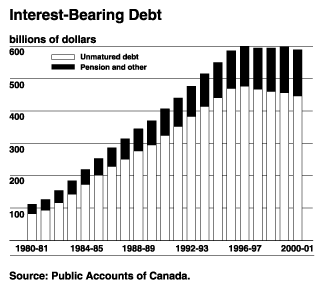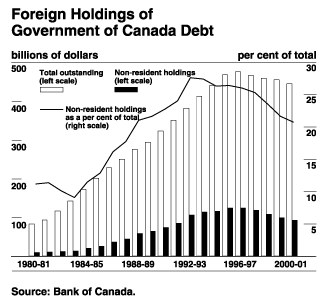|
|
|
|
|
|||||||
|
|
Annual Financial Report 2000-2001: 4
- Table of Contents - Previous - Next -
The Budgetary Balance, Financial Requirements/Source and Debt
The budgetary balance is the most comprehensive measure of the federal government’s fiscal results. It is presented on a modified accrual basis of accounting, largely recording government liabilities when they are incurred, regardless of when the cash payment is made, and recording tax revenues only when cash is received. The budgetary balance covers only those activities over which the Government has legislative control.
In contrast, financial requirements/source measures the difference between cash coming in to the Government and cash going out. It differs from the budgetary balance in that it includes transactions in loans, investments and advances, federal employees’ pension accounts, other specified purpose accounts, and changes in other financial assets and liabilities. These activities are included as part of non-budgetary transactions. The conversion from modified accrual to cash accounting is also reflected in non-budgetary transactions.
Non-budgetary transactions in 2000-01 resulted in a net source of funds amounting to $1.8 billion, compared to a net source of $2.3 billion in 1999-2000. Among the major components:
- Loans, investments and advances recorded a net requirement of $1.7 billion, primarily due to the federal government reassuming administration of and borrowings for the Canada Student Loans program from the major banks.
- Pensions and other accounts recorded a net source of funds of $1.3 billion, compared to $7.0 billion in 1999-2000. The lower source primarily reflects the reforms of the federal government employees’ pension plans, effective April 1, 2001. Employer and employee contributions to the plans are now invested in financial markets, rather than being included as part of non-budgetary transactions. This reduces the non-budgetary source of funds by about $3 billion per year. In addition, a number of Crown corporations, which were members of the public sector pension plans, have set up their own pension plans, thereby resulting in the transfer of the applicable assets to these new plans.
- Other transactions recorded a net source of $2.2 billion, compared to a net requirement of $4.4 billion in 1999-2000.
With a budgetary surplus of $17.1 billion and a net source of funds from non-budgetary transactions of $1.8 billion, there was a financial source, excluding foreign exchange transactions, of $19.0 billion in 2000-01, up from the financial source of $14.6 billion in 1999-2000. This marks the fifth consecutive year in which a financial source has been recorded.
Financial requirements/source includes foreign exchange transactions. Foreign exchange transactions represent all transactions in international reserves held in the Exchange Fund Account. The purpose of the Exchange Fund Account is to promote order and stability in the foreign exchange market. The buying of Canadian dollars represents a source of funds from exchange fund transactions, while the selling of Canadian dollars represents a requirement. Changes in foreign currency liabilities, which are undertaken to change the level of Canada’s foreign exchange reserves, also impact on foreign exchange transactions. Taking all of these factors into account, there was a requirement of $8.8 billion in 2000-01, compared to a requirement of $6.8 billion in 1999-2000.
As a result, there was a net financial source – the budgetary surplus plus non-budgetary and foreign exchange transactions – of $10.2 billion in 2000-01, compared to a net financial source of $7.7 billion in 1999-2000.
With this net financial source, the Government retired $10.0 billion of its market debt and increased its cash balances by $0.2 billion. Cash balances at March 31, 2001, stood at $13.2 billion.
Total liabilities consist of interest-bearing debt and other liabilities. Interest-bearing debt includes market debt and liabilities for pension and other accounts. At March 31, 2001, interest-bearing debt amounted to $589.2 billion, down $8.7 billion from the level a year earlier. Other liabilities, which include accounts payable and accrued liabilities, amounted to $43.6 billion, up $2.9 billion from 1999-2000. As a result, total liabilities, or gross debt, stood at $632.9 billion.

Financial assets consist of cash and accounts receivable, foreign exchange accounts and loans, investments and advances. Capital assets, inventories and net receivables for tax revenues are not currently included, but will be when the Government moves to full accrual accounting at the end of 2001-02. Capital assets and inventories are fully charged to expenditures at the time of acquisition or construction while tax revenues are reported on a cash basis. Financial assets totalled $85.5 billion at March 31, 2001, up $11.3 billion from March 31, 2000, primarily attributable to increased assets in the foreign exchange accounts, as the government continued to increase foreign exchange reserves to be more in line with other comparable countries. The assets in the foreign exchange reserve earn interest, which is reported as part of budgetary revenues. In 2000-01 gross revenue was $2.3 billion, up $0.4 billion from 1999-2000.
As a result, the accumulated deficit, or net public debt, stood at $547.4 billion at March 31, 2001, down $17.1 billion from March 31, 2000, and $35.8 billion below the peak of $583.2 billion at March 31, 1997.
Foreign holdings of the Government of Canada’s outstanding market debt are estimated at $97.3 billion at the end of March 2001. This represents 20.8 per cent of the Government’s total market debt – the lowest ratio since 1987-88.

Table 4
Budgetary Balance and Financial Requirements/Source
|
|
||||||||
|---|---|---|---|---|---|---|---|---|
|
1993-94 |
1994-95 |
1995-96 |
1996-97 |
1997-98 |
1998-99 |
1999-00 |
2000-01 |
|
|
|
||||||||
|
($ billions) |
||||||||
|
Budgetary balance |
-42.0 |
-37.5 |
-28.6 |
-8.9 |
3.5 |
2.9 |
12.3 |
17.1 |
|
Non-budgetary transactions |
||||||||
|
Loans, investments |
||||||||
|
and advances |
0.6 |
0.3 |
2.7 |
0.3 |
2.0 |
0.5 |
-0.3 |
-1.7 |
|
Pensions and other accounts |
||||||||
|
Public sector pensions (net) |
6.2 |
6.9 |
6.8 |
6.3 |
3.3 |
5.0 |
5.9 |
0.8 |
|
Canada Pension Plan |
-0.1 |
0.7 |
0.2 |
0.1 |
0.5 |
1.2 |
0.8 |
0.2 |
|
Other |
0.2 |
1.0 |
0.6 |
0.5 |
0.1 |
0.9 |
0.2 |
0.3 |
|
|
||||||||
|
Total |
6.2 |
8.7 |
7.6 |
6.9 |
3.8 |
7.0 |
7.0 |
1.3 |
|
Other transactions |
5.4 |
2.6 |
1.1 |
3.0 |
3.4 |
1.1 |
-4.4 |
2.2 |
|
|
||||||||
|
Total |
12.2 |
11.6 |
11.4 |
10.2 |
9.3 |
8.6 |
2.3 |
1.8 |
|
Financial requirements/source |
-29.9 |
-25.8 |
-17.2 |
1.3 |
12.7 |
11.5 |
14.6 |
19.0 |
|
Foreign exchange transactions |
-2.1 |
-1.4 |
-4.7 |
-7.8 |
-2.2 |
-5.7 |
-6.8 |
-8.8 |
|
Financial balance |
-32.0 |
-27.3 |
-21.9 |
-6.5 |
10.6 |
5.8 |
7.7 |
10.2 |
|
Change in borrowings |
31.2 |
27.0 |
28.5 |
7.3 |
-9.6 |
-6.9 |
-4.0 |
-10.0 |
|
Change in cash balances |
-0.7 |
-0.2 |
6.7 |
0.8 |
1.0 |
-1.1 |
3.7 |
0.2 |
|
Cash in bank (March 31) |
2.1 |
1.9 |
8.6 |
9.4 |
10.4 |
9.3 |
13.0 |
13.2 |
|
|
||||||||
Table 5
Outstanding Debt at Year-End
|
|
||||||||
|
1993-94 |
1994-95 |
1995-96 |
1996-97 |
1997-98 |
1998-99 |
1999-00 |
2000-01 |
|
|---|---|---|---|---|---|---|---|---|
|
|
||||||||
|
($ billions) |
||||||||
|
Interest-bearing debt |
||||||||
|
Unmatured debt |
414.0 |
441.0 |
469.5 |
476.9 |
467.3 |
460.4 |
456.4 |
446.4 |
|
Pension and other accounts |
100.5 |
109.2 |
116.9 |
123.7 |
127.5 |
134.6 |
141.5 |
142.8 |
|
|
||||||||
|
Total |
514.5 |
550.2 |
586.4 |
600.6 |
594.8 |
595.0 |
597.9 |
589.2 |
|
Other liabilities |
31.9 |
34.6 |
38.3 |
40.1 |
43.7 |
45.3 |
40.7 |
43.6 |
|
Total liabilities (gross debt) |
546.4 |
584.8 |
624.7 |
640.7 |
638.5 |
640.3 |
638.7 |
632.9 |
|
Financial assets |
38.2 |
39.1 |
50.4 |
57.5 |
58.8 |
63.5 |
74.2 |
85.5 |
|
Accumulated deficit |
||||||||
|
(net public debt) |
508.2 |
545.7 |
574.3 |
583.2 |
579.7 |
576.8 |
564.5 |
547.4 |
| Last Updated: 2002-02-23 | |||||